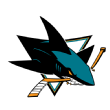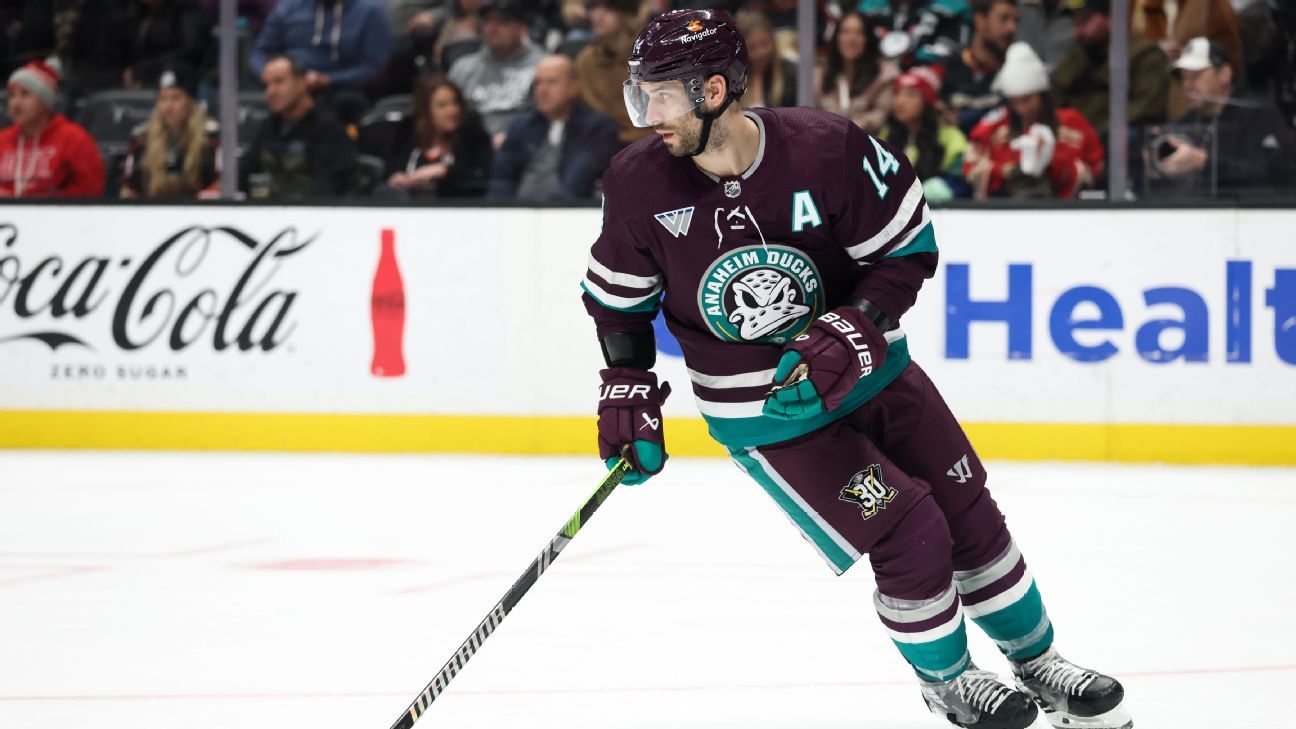The 2023-24 NHL trade season is well underway, kicked off by the Elias Lindholm trade on the eve of All-Star Weekend.
So who gets moved next, ahead of the March 8 deadline?
The Stanley Cup won’t be won at the deadline, but there are some gaps contending teams must fill. We’ve tapped ESPN reporters Ryan S. Clark, Kristen Shilton and Greg Wyshynski to devise two trades apiece — of benefit to both teams, and keeping in mind the relevant salary cap implications.


New York Rangers get:
C Adam Henrique (at 50% of salary), RW Frank Vatrano (at 75% of salary)

Anaheim Ducks get:
C Barclay Goodrow, LW Adam Sykora, C Noah Laba, 2024 first-round pick, 2026 third-round pick
Why it works: With season-ending injuries to Filip Chytil and Blake Wheeler, the Rangers have needs at center and right wing. The Ducks have players who could fill those needs, but New York has to make the math work.
Henrique, 34, is a veteran center on an expiring contract. Although it would break Devils’ fans hearts to see him in a blue shirt, Henrique fits well: He had 37 points in 56 games, plays on both special teams and wins over 53% of his faceoffs. Vatrano, 29, knows the Rangers, having played 22 games there in 2021-22. Most of all, he knows Mika Zibanejad and Chris Kreider, having been a successful linemate with them on the right side. He has become a better player in Anaheim and is signed for an additional season.
How do the Rangers make the trade work? The easiest way might be to finally part ways with Kaapo Kakko, but he has settled into a depth forward role this season and I’m not convinced the Rangers want to punt on the No. 2 pick from 2019 yet.
So to make the trade work, the Ducks would have to retain 50% on Henrique and 25% on Vatrano, plus take on Goodrow’s contract: $3,641,667 average annual value through 2026-27. To entice them to do so, the Rangers ante up a first, a third and two good prospects: Sykora, a tenacious AHL winger who is only 19 and could have offensive upside, and Laba, a 20-year-old center at Colorado College. — Wyshynski

New Jersey Devils get:
G Jacob Markstrom (at 80% of salary)

Calgary Flames get:
C Dawson Mercer, RW Alexander Holtz, retain 20% of Markstrom’s salary
Why it works: Rumor has it the Devils and Flames already attempted a trade involving Markstrom (to which he — with a no-movement clause — agreed) and it fell apart somewhere along the way. No problem. We’re cooking up another scenario here that would actually benefit both parties in a who-says-no kind of way.
New Jersey requires an upgrade in net like perhaps no other playoff-focused team in the league. Vitek Vanecek took a serious step back this season, and the Devils haven’t been able to rely on him or Akira Schmid to get the job done nightly. Enter Markstrom. The veteran netminder is having a terrific season, and reading between the lines of what he has said about the possibility of being traded out of Calgary, Markstrom might be happier on a team that’s still potentially postseason-bound. He’s also signed for two more years at a reasonable $6 million per season, and if the Flames retained salary in the deal, that just mitigates some of the risk surrounding Markstrom’s age (34).
In return, the Flames get what they need — young players to grow within their organization. Holtz appears to have fallen out of favor with New Jersey coach Lindy Ruff and has been continuously pushed down the lineup. The 22-year-old is on his entry-level contract for another year and is bursting with potential that Calgary could pull out of him as it has with other up-and-comers this season.
Then there’s Mercer. He’s a 22-year-old center who has been in the shadows of Nico Hischier and Jack Hughes in New Jersey. Calgary could allow Mercer to rise from just a middle-six afterthought to a bona fide play driver. The Flames are obviously eyeing their future with any moves made now. Parting with Markstrom in return for some burgeoning early-20s skaters would be a good step toward brighter days. — Shilton

Florida Panthers get:
LW Jake Guentzel (at 25% of salary)

Pittsburgh Penguins get:
2024 third-round pick, 2025 second-round pick, 2026 first-round pick, retain 50% of Guentzel’s salary

Chicago Blackhawks get:
2025 fourth-round pick (CGY, from FLA), retain 25% of Guentzel’s salary
Why it works: Panthers general manager Bill Zito has made massive trades around the deadline before — namely in 2022 when Florida mortgaged quite a bit to get Ben Chiarot and Claude Giroux, only to then get swept in the second round. But since then, the Panthers have gone from being a team that struggled to gain traction in the first two rounds to one that has used the past 12 months to show it is a legitimate Stanley Cup contender.
Their run to the 2023 Stanley Cup Final explains why it makes sense for them to go after Guentzel, who is on long-term injured reserve and will return on March 10 at the earliest. While injuries decimated their lineup last spring, the Panthers played against a Las Vegas roster that had superb scoring depth. Adding Guentzel would give them that, considering he’s a two-time 40-goal scorer who has added 34 goals in 58 playoff games.
Even though parting with Guentzel could prove difficult, the Penguins would at least be able to add quite a bit of draft capital. The Penguins are currently without their first-, third- and fifth-round picks in 2024, so this haul would help address their relative shortcomings (and give them two firsts in 2026). But bear in mind, a Guentzel deal happens only if the Penguins believe the wild card is too far out of reach. — Clark

Vegas Golden Knights get:
LW Pavel Buchnevich

St. Louis Blues get:
2024 first-rounder, 2025 second-rounder, C Brendan Brisson, D Lukas Cormier
Why it works: Blues GM Doug Armstrong has never been shy about selling when his team is on the edge of the playoff bubble. Golden Knights GM Kelly McCrimmon has never met a deadline trade he couldn’t make — especially when Vegas’ long-term injury situation, and its salary cap relief, presents the opportunity to do so. With captain Mark Stone laid up with a lacerated spleen for the foreseeable future, McCrimmon has another opportunity at this deadline.
These two teams hooked up on an Ivan Barbashev trade last season, a deal that helped Vegas win its first Stanley Cup. They do business again with another talented winger in Buchnevich, who has 22 goals and 24 assists in 55 games this season. The 28-year-old is signed through next season at a $5.8 million annual cap hit and has a 12-team no-trade list. The Blues would be selling high on him one year before unrestricted free agency.
The scuttlebutt is that Armstrong wants a return for Buchnevich that rivals what the Canucks traded to Calgary for Elias Lindholm. The Knights don’t have a roster player like Andrei Kuzmenko they’d want to give up here, so it would have to be a package of futures instead: 22-year-old Brisson, 21-year-old Cormier, a first-rounder and a second-rounder for two years of Buchnevich — a player who could help Vegas lift the Cup again in the next two seasons. — Wyshynski

Dallas Stars get:
D Chris Tanev (at 25% of salary)

Calgary Flames get:
D Nils Lundkvist, 2024 first-round pick, 2024 second-round pick, retain 50% of Tanev’s salary

Columbus Blue Jackets get:
2025 fifth-round pick (NJ), retain 25% of Tanev’s salary
Why it works: This appears to be one of those hypotheticals that meets the needs for everyone involved.
For the Stars, this would give them that right-handed partner for Miro Heiskanen, which would then allow him to go back to his natural side. Having a Heiskanen-Tanev combination could also give the Stars the sort of top pairing that’s capable of logging heavy minutes and is trusted to consistently challenge top lines.
“The future” would be the selling point for the Flames in this deal. Lundkvist would give them a young defenseman who has played more than 100 NHL games. He’s also going to be a pending restricted free agent at the end of the season who will remain under team control until 2027-28. That could prove crucial for the Flames, given they have five defensemen on their current roster who will be unrestricted free agents at the end of the season. Having a first-rounder and a second-rounder would give the Flames three first-round picks in this year’s draft with a total of five picks over the first two rounds.
As for the Blue Jackets, they’d be able to parlay their cap space into draft capital by serving as a third-party broker. — Clark

Edmonton Oilers get:
RW Jordan Eberle (at 25% of salary)

Seattle Kraken get:
2024 first-round draft pick, RW Tyler Tullio, retain 40% of Eberle’s salary

San Jose Sharks get:
2025 third-round draft pick, RW Connor Brown, retain 35% of Eberle’s salary
Why it works: The crux of this deal is Edmonton reuniting with its 2008 first-round draft pick.
It’ll be tough for the Oilers to make any moves at the trade deadline given their salary cap constraints, but they can manage 25% of Eberle’s $5.5 million hit if another team — such as San Jose — is involved and willing to help. The Sharks have been a third wheel before; they’d likely do it again for a higher-round draft pick and a player to help them out through at least the end of this season.
But back to Eberle. He’s 33 now, a well-seasoned pro and playing some of his best hockey. Edmonton needs scoring depth. Eberle can provide it in a second- or third-line role for the Oilers and potentially be part of a special run this spring that feels only too fitting given the history between team and player. — Shilton
